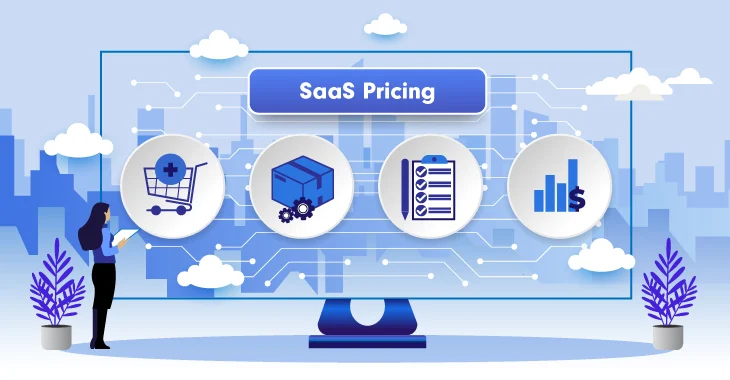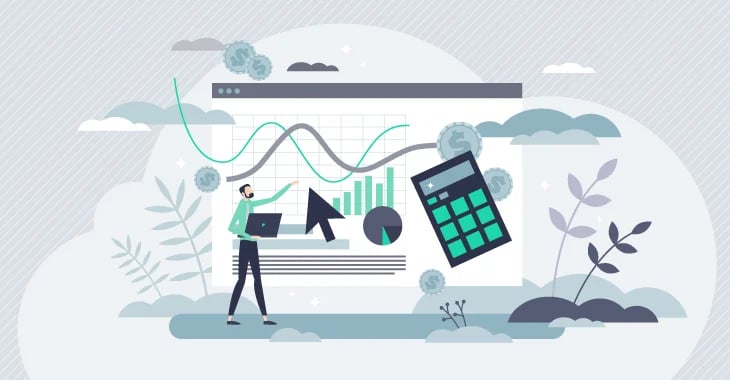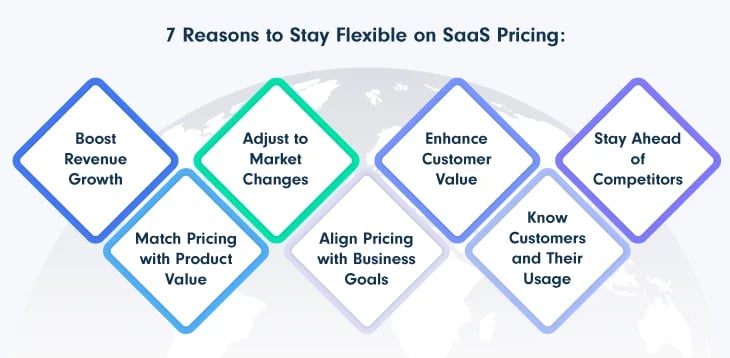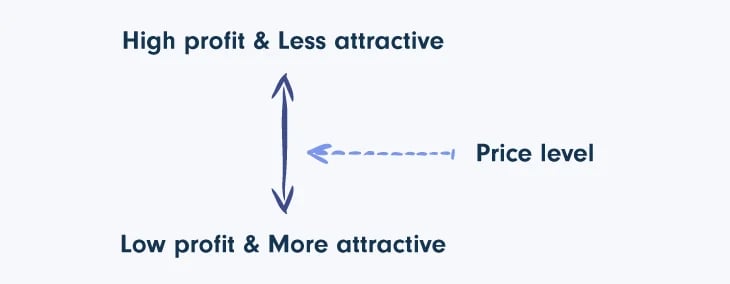7 Reasons to Remain Flexible About SaaS Pricing

Being flexible about your SaaS pricing is crucial to maximizing revenue. In fact, according to ProfitWell, improving price optimization by just 1% can boost profits by an average of 11.1%.
Imagine the potential growth possible when you ensure your pricing model is consistently a core focus for your business.
Most SaaS companies, however, treat pricing as an afterthought, setting and forgetting it rather than treating SaaS flexible pricing strategies as ongoing processes that are central to their success.
Having a fixed monthly price that does not particularly reflect the true value of the product or the customers’ willingness to pay is, unfortunately, a common behavior.
Research has found that companies only spend 6 hours on pricing when realistically, they should be re-evaluating their strategy every 3 months.
You need to be willing to commit the necessary resources toward research in pricing strategy, so it aligns with your company goals, competitors, and the broader economy and marketplace.
And with 98% of SaaS companies showing positive results following core changes in their pricing policy, there's little reason not to give it the attention it deserves. Dive into our guide to SaaS pricing to learn why monetization flexibility is worth having and how it can help with your SaaS retention.
What Are Pricing and Pricing Strategies?
To state the obvious, pricing refers to how much you charge customers for your products or services. To stay competitive, sellers need to consider building a flexible pricing policy.
But (and here is the part that is not so obvious), there are many variables to consider before landing on a specific amount.
Your strategy will guide your SaaS pricing model and help you determine how much you should charge for your offering.
There are many SaaS pricing strategies to consider, but among the most common ones are:
Cost plus pricing
Value-based pricing
Competitor based pricing
Cost based pricing
Selecting the right pricing strategy for your business requires an in-depth understanding and constant reassessment of your product’s value, the market in which you operate, and your customer segment.
Additionally, when speaking of pricing, we need to differentiate between models and strategies. To successfully price their products, small businesses and enterprise companies should create a solid mix of SaaS pricing strategies and models.
To make this simpler for you, here are several popular options you should consider when building your monetization approach:
Flat rate pricing
Tiered pricing
Feature pricing
Usage pricing
Flat rate pricing
Freemium pricing
Why Developing an Effective Pricing Strategy Is Important
Many SaaS companies need to be proactive about pricing for several reasons. Finding a flexible pricing model for your business that allows you to maintain a competitive price that eliminates part of the existing SaaS risk may take a lot of work and time, but it is worth it. Here is why.
First of all, your customers can go elsewhere if they feel like their needs aren’t being met or if they discover a more appealing value proposition.
Remember that the SaaS and software landscape enjoys a high market demand. It's a highly competitive environment, with a good chance your competitors are nipping at your heels.
Secondly, your pricing needs to keep up with the value you offer customers. As you constantly work to improve your SaaS product and its features, the value of that product increases, and so should its price. You must be prepared to adjust prices based on product changes and even shifting competitor monetization strategies.
You're also not operating in a vacuum, so your pricing should be flexible enough to adapt to the prevailing market conditions. This is actually why there are so many popular pricing models.
Achieving pricing flexibility will help you stay on top of your business goals and satisfy your buyers.
7 Reasons to Remain Flexible About SaaS Pricing
Being flexible about how your customers pay is a must in today’s business world. Being ready to switch from a tiered pricing model to a per-active user pricing is definitely something you need to work on to achieve.
SaaS companies need to constantly optimize their pricing model and strategies to fit not only market changes but their product updates and customer expectations. This could mean anything from offering discounts to having flexible prices.
Your Unique eCommerce partner
Stop second-guessing the right price for your product. Trust PayPro Global to help you with your SaaS pricing strategies and start growing your business with our complete payments solution. Driving revenue has never been simpler.
1. Maximize Revenue Growth
Your business isn't static, so your subscription pricing shouldn't be either. By optimizing your strategy, you can maximize the subscription revenue you receive per customer, helping you grow faster. This is particularly important if you're looking to scale quickly within the SaaS Industry.
For example, SaaS startups may initially take a more competitive approach to pricing by lowering prices to attract customers, but they'll need to adjust as they grow to maximize revenue. The final price needs to meet profit margins and fit customer expectations.
Yes, flexibility in your pricing strategy requires a balanced approach – you don't want to deter customers with exorbitant costs, but you also don't want to undersell your products.
Keep in mind that pricing is a process that needs to constantly be reviewed throughout your business journey.
2. Align Pricing with Product Value
When adjusting your pricing, you should follow the Goldilocks principle – it should be just the right amount of money customers are willing to spend.
Starting out, you may price your products low enough to attract customers, but as you grow, this amount will become less viable for your business.
Even though it might seem that low prices will increase sales, this strategy could backlash. Priced too low, your product risks being deemed cheap and of poor quality. At the other end of the scale is a product priced too high.
While it may be perceived as being of higher value, it may be more than your target audience is willing to spend and could discourage new customers.
The right price falls between these two extremes, so you must constantly adjust your pricing as you grow and add more features, ensuring it aligns with your product's value.

3. Adapt to Changing Market Conditions
SaaS businesses operate in a very dynamic environment, with technology, customer behavior, and the marketplace always in flux.
The pandemic, for example, forced companies to adapt quickly, impacting pricing structures. Some companies may have lowered their prices to remain viable, while others raised them as demand for certain products and services rocketed.
Some decided to switch from the feature-based pricing model to the now popular user-based pricing.
Technology and the rising tide of automation also have a major influence on market dynamics. While being agile and responsive to new SaaS trends is vital, you must be flexible enough in your pricing strategy to respond to these advances.
AI integration, for example, is driving innovation and efficiency across software services — whether your SaaS is already at that level or not should reflect in your pricing.
4. Keep Pricing in Line with Business Goals
As your business goals evolve, your pricing strategy should always be aligned. Whether your objectives are growth, stabilization, or survival, pricing trials will help you reach optimized levels for whatever you're trying to achieve.
If you're targeting sales growth, for example, you may adjust your pricing to raise sales volumes, which will have a direct positive impact on your bottom line.
If your goal is maximum market penetration, you’ll want to charge the lowest possible price to rapidly gain market share and expand. The freemium pricing model could be used in this particular instance. A stabilizing strategy requires pricing that's in line with your competitors but ultimately maintains your profit margin.

5. Maximize Customer Value
How you price your products and services should be based not only on how you measure their value but also on their perceived customer value.
Keeping your customers top of mind during price optimization ensures maximum revenue and an enhanced value proposition. A sound strategy is to price your product's value rather than just the product itself.
Interviews, surveys, and tracking your SaaS metrics are effective ways to gauge customer value. But understanding how many users agree with your pricing perspective is relevant. A high churn rate could indicate a low perceived value and that your pricing may not align with your customer's expectations.
It's important to note that customers' perceived value changes over time due to external factors such as technological shifts and the marketplace.
You should always take this into account when adjusting your pricing.
6. Understand Your Customer Segment and Usage Patterns
Being flexible about your pricing requires really getting to know your customer segment and their usage patterns.
When you understand your customers, you recognize their price sensitivities, allowing you to optimize costs and set the most appropriate pricing strategy.
In fact, as you work to identify audience segments, you might come to the obvious conclusion that shifting from a stand-alone offer to different prices is the right approach.
Many businesses operating within the SaaS sphere function on multiple pricing packages to ensure multiple customer segment satisfaction.
Constantly monitoring their usage patterns and developing pricing plans that meet their exact cyclical requirements will help satisfy your customers.
This data also reveals how they change their consumption habits over time, allowing you to adapt your pricing approach accordingly. Tracking usage patterns will help decide your pricing, ensuring it remains dynamic and that your products remain profitable.
7. Stay Ahead of the Competition
Pricing is a helpful tool in achieving your business's competition-related objectives, one of which is to gain a competitive advantage.
Optimized at the most attractive price-to-value ratio, the competitive based pricing strategy will help you gain more customers and even win some over from your competitors.
Pricing can also be used to prevent new players from joining the marketplace. By keeping prices as low as possible, it becomes unviable for them to operate.
While this strategy may minimize profits or even result in you selling at a loss, it may help limit competition and maximize customer acquisition and retention.
At the other end of the scale, high pricing can be used to signal high-quality value, creating the perception among shoppers that your product is top of the range while your competitors may be cheap and inferior.

Benefits of Testing Different Pricing Models and Strategies
More Effectively Market Your Product
Being flexible about your pricing means constantly engaging with and trying to better understand your target market to gauge how they value your offering and how much they're willing to pay for it.
This information not only helps you optimize your pricing but can help you develop an effective subscription marketing strategy so that you target the right customers and can highlight the value of your offering convincingly.
Increased Efficiency in LTV:CAC Ratio
A low ratio between your lifetime value per customer (LTV) and customer acquisition costs (CAC) means a longer time to achieve growth. By continually optimizing your pricing strategy, CAC can be paid back much sooner.
This efficiency in the LTV:CAC ratio has a positive knock-on effect on profitability and, therefore, growth.
Rather than investing more money in customer acquisition, being flexible in your pricing strategy allows you to optimally monetize customers and reap the rewards sooner.
Build Stronger Customer Relationships
Flexibility in SaaS pricing allows you to establish clear pricing plans that can help you develop strong customer relationships.
Going through the continual process of trying to understand your customers' wants and needs to align your pricing with their perceived value and willingness to buy will lead to greater brand loyalty over time, boosting your customer retention.

Lower Customer Churn
If your products or services are priced too high, your customers may feel like they're not receiving value for money and move on to your competitors.
However, the reverse is also true – if your prices are too low, customers may perceive your offering as low quality and look elsewhere for a higher-quality product. Optimizing your pricing to line up with its true value while also considering your target segment's willingness to buy will help keep your customers satisfied and reduce churn.
Better Manage Your Finances
Constantly reprising your SaaS pricing strategy will help you consistently re-evaluate your income and expenses, helping you stay on top of your finances and better manage your resources.
This continual overview will help you make informed decisions in other key business areas, boosting your growth strategy in the long term.
What a Pricing Update Entails
Carry Out Market Research
When you start to optimize your pricing, you'll want to spend a fair amount of time on market research and analysis, looking at the different buyer personas in your customer base as well as the current shape of your market segment.
Over time, this process will be streamlined as you'll be able to reuse some of the research you gather in future pricing adjustments. Market research is one of the key resources to guide any decisions you make around pricing.
Select Your Pricing Strategy
After adequate market research, you'll need to choose a pricing strategy on which you can base your pricing tiers, and one that fits your individual needs.

In selecting a pricing strategy, you'll need to consider your buyer personas, customers' perceived value of your products, customer LTV, your competitors' prices, and your growth stage – data that you would have acquired during the research phase.
Check-In With Existing Customers
Chances are your existing customers will not be happy about an increase in pricing, but it will still be helpful to gather their feedback through surveys to gauge their sentiment about your product and how it adds value.
You'll also be able to engage with them on some of your concerns and answer any questions they may have.
Evaluate the Impact of Your Pricing Update
To ensure your new pricing structure does not have a severely negative impact on your existing customers, run an analysis to determine how they may be affected.
Understand how much customers are willing to pay as well as how much value your product brings. It’s important to have a solid understanding of the concept of value from both parties involved.
To prevent a high increase in churn, either transition them to the new pricing incrementally over time or offer particularly price-sensitive segments a transition rate.
Develop a Customer Communications Plan
Once you've decided to change your pricing, you need to ensure you have a good customer communications plan in place so as not to lose them during the transition. Provide them with easy-to-understand information and access to more resources should they need them.
Backpedaling on a price increase is frowned upon, so ensure you're confident in your decision before making a change, or you risk frustrating your customers.
Also, ensure your team is 100% equipped with the right pricing information when dealing with customers.
Your Unique eCommerce partner
Stop second-guessing the right price for your product. Trust PayPro Global to help you with your SaaS pricing strategies and start growing your business with our complete payments solution. Driving revenue has never been simpler.
How Can PayPro Global Help?
Using our complete, all-in-one eCommerce solution, you have the tools to effectively test common SaaS pricing models and verify which option suits your business best.
From trials or per-user pricing to the freemium model or demos, PayPro Global allows your SaaS business to identify the right way to engage different customer profiles and, ultimately, validate the best-performing model for your needs.
With a powerful solution by your side, you can increase customer lifetime value by making use of dedicated features like coupons or promotion management.
Additionally, with our AI-powered SaaS analytics and BI tools, you can predict customer costs and revenue and back all your business decisions, including how to best optimize your pricing page, with real-time data.
You can easily track and measure the entire SaaS sales process, using over 70 reports, and build the best SaaS pricing strategy capable of substantially boosting your revenue. With PayPro Global’s analytics features, you are considerably streamlining an otherwise time-consuming task.
Closing Thoughts on Why You Need to Remain Flexible About SaaS Pricing
Being flexible about pricing is necessary if you want to succeed in SaaS, particularly as the space becomes increasingly competitive, offering a wide array of options for paying customers. eCommerce partners can be of great help in obtaining access to strong payment infrastructures.
Playing with popular SaaS pricing models will allow you to adequately predict revenue and set price points that fit your target audiences, especially if you wish to expand your business worldwide.
Your pricing strategy needs to make sense for you and your customers, but because the marketplace is always changing, setting and forgetting your pricing comes with risks.
Continuously evaluating your pricing packages, much as you do other SaaS metrics, will help set your SaaS company up for success.
Partner with PayPro Global for pricing and payment operations to suit all your needs and those of your existing and potential customers.
From custom pricing to trial management or premium features, we'll ensure you choose the right pricing model for your SaaS, most likely to produce long-term successful results.
Visit PayPro Global or reach out to find out how we can help you stay on top of your SaaS pricing strategy.
Ioana Grigorescu
Ioana Grigorescu is PayPro Global's Content Manager, focused on creating strategic writing pieces for SaaS, B2B, and technology companies. With a background that combines Languages and Translation Studies with Political Sciences, she's skilled in analyzing, creating, and communicating impactful content. She excels at developing content strategies, producing diverse marketing materials, and ensuring content effectiveness. Beyond her work, she enjoys exploring design with Figma.
-
1.Explore PayPro Global's Solutions: See how our platform can help you streamline your payment processing and boost revenue.
-
2.Get a Free Consultation: Discuss your specific needs with our experts and discover how we can tailor a solution for you.
-
3.Download our Free Resources: Access valuable guides, checklists, and templates to optimize your online sales.
-
4.Become a Partner: Expand your business by offering PayPro Global's solutions to your clients.
Get the latest news



